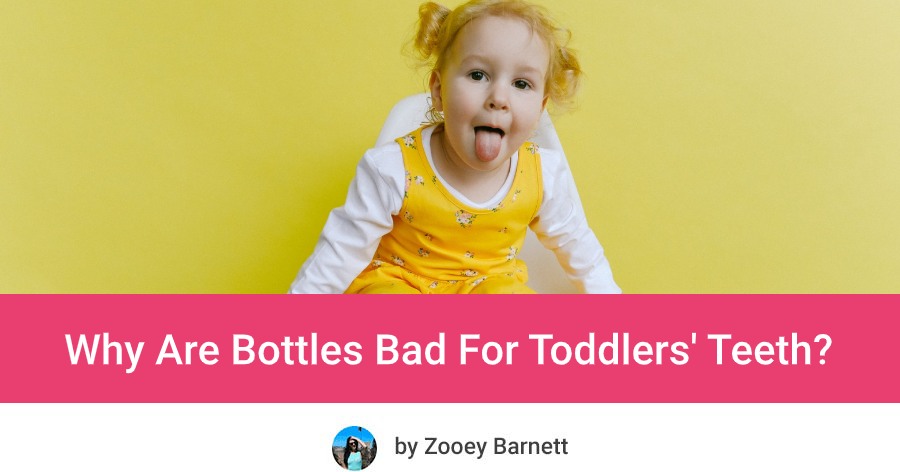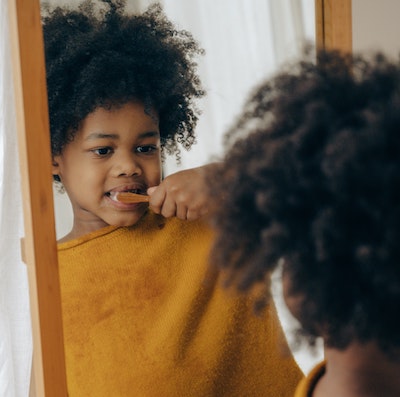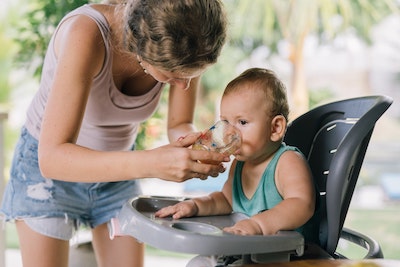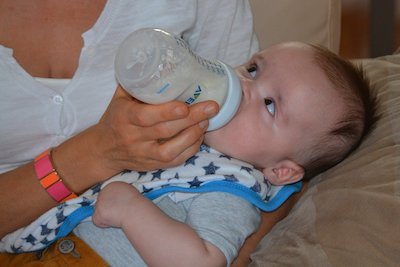Babies and bottles are an inseparable duo. But are the bottles and pacifiers as harmless as they seem? Unfortunately, the answer is no. Generally speaking, babies should say goodbye to their bottles by the age one (never later than 18 months).

This article in NOT a substitute for medical advice
If you don’t start weaning your baby off the bottle before 18 months, there will be some negative side effects. The main one is tooth decay. Tooth decay in toddlers is directly related to overusing bottles and pacifiers. Still not convinced? Let’s dig deeper into the subject and answer the burning question: Why are bottles bad for toddlers’ teeth?
Prolonged Bottle Feeding – Why Is It Bad?
As much as bottles provide both nutrients and comfort to babies, bottle feeding after the age of one can do more harm than good. Especially to baby’s teeth. The negative effects of prolonged bottle-feeding can lead to tooth decay in toddlers and also leave them with bad teeth later in life.
When your child is drinking sweetened drinks from a bottle for more than a year, it can lead to cavity formation. Okay, you may now be thinking “My baby is safe because I’m only giving him breastmilk, no juices!”. That’s a common mistake. Natural sugars that breast milk contains can be just as harmful as sugary drinks and regular milk.
The longer children use the bottle, the higher is the chance that they will get cavities1. The reason is simple – this is the prolonged effect of bottle decay.

Putting your little one to sleep with a bottle of milk or juice can be the biggest threat. That’s the perfect environment for the cavities as the sugar attaches to the child’s teeth and the saliva that naturally protects the teeth is reduced. Besides, you should never leave your baby with a bottle in a crib, even if your baby can already hold their bottle, as it poses risk of choking!
If you think that baby teeth will fall out anyway and there is no long-term harm, that’s not the case. Baby bottle tooth decay2 can get the teeth infected and your child can lose them too early. The problems that arise from this can be severe:
- Speech problems
- Poor eating habits
- Crooked teeth
- Damaged adult teeth
Besides the cavities, another problem that can come from prolonged bottle feeding is improper dental development. Consistent sucking on a bottle (or pacifier) can misalign existing and incoming baby teeth. The worst part is that this misalignment isn’t necessarily temporary. It can remain with permanent teeth as well.
Using a bottle and a pacifier for over 12 months means that the baby is repeatedly making the same motion. That motion puts their front teeth over their lower teeth. Because of that, a child can develop an overbite. An overbite will keep their front teeth open even when they close the mouth.
Another side effect of using the bottle for too long is higher risk of obesity in children.
The harmful effects of bottle feeding toddlers are undeniable. However, knowing when and how to wean your baby off the bottle is a good start.
Bye, Bye Bottle – When And How To Start Weaning Babies From Bottles
The best time to start teaching your child that life without a bottle is possible is around the first years. By the time they turn one, the children already have the hand skills and coordination to hold the cup. The most important signal that your child is ready to move to a cup is when it can sit up straight.

The American Academy of Pediatrics (AAP) recommends that parents completely wean their children off the bottle by the time they are 15 to 18 months old3. So, starting with the process when your child is 12 months old isn’t a bad time to start.
To make this transition more gradual you can start introducing the cup to your baby when it’s 6-12 months old. Don’t cut it off all at once. At the beginning replace one bottle feeding in a day with a cup. Take it step by step. Even if it gets spilled, the baby will get more familiar with using a cup.
Don’t wait too long to make the transition from the bottle to a cup because the longer you wait the harder the weaning will be. With time, kids become more attached to their bottles (and pacifiers) and don’t want to let go.
Doctors recommend that babies can start drinking whole milk around the age of one4, and water from around 6 months or when they start eating solids (water is not recommended before 6 months)5.
This can be the perfect timing to make the changes and wean off the bottle simultaneously – introduce them with the cup and water/cow’s milk. However, if you are still breastfeeding you can simply put your milk into the cup.

Now, all the parents out there whose child is two years old and still on the bottle can ask the following: How bad is it that my 2-year-old is still on the bottle? It’s not a problem that can’t be fixed, but if you don’t start weaning your child off the bottle it can cause some serious issues.
Aside from rotten kid teeth, prolonged bottle use can also be the source of obesity in children. One study has shown that two-year-olds who are still on the bottle are more likely to be obese than kids who were weaned earlier6.
Tips For Parents
You’re now aware that bottle-feeding after the age of one is bad for your baby’s teeth. But what can you do to get your 2-year-old off the bottle? Don’t worry, there are useful methods that will help your child adapt to bottle-less life.
Here are some helpful tips you can try out with your toddler:
- Start introducing half or one cup a day (depending on baby’s age and needs).
- Add water in their bottle (1/2 water and 1/2 milk) and increase the amount of water with time. This will make the bottle less enjoyable and the child will lose interest. *Keep in mind that pediatrician do not recommend water before 6 months of age. Consult with your doctor when can you introduce water to your baby.
- Put the bottle out of sight.
- Introduce the cup during mealtimes. Instead of the bottle, offer them food and follow up with a cup.
- Give your child a cup instead of the fist or the second bottle. If they start questioning why say that they’ll get the bottle later to calm them down.
- The bedtime bottle is the toughest one to eliminate. So, instead of the bottle, give them milk in a cup or a snack and distract them with relaxing techniques such as reading bedtime stories.
- Use an open cup or a free-flow cup so that the child sips and not sucks. It is less harmful to the teeth.
- Offer positive reinforcement and praise.
Final Thoughts
Weaning children off bottles can be one of the biggest challenges for parents. We have to take something our child wants despite their protests. However, if you keep in mind how bottle-feeding can affect your toddlers’ teeth, you’ll be motivated to be persistent until you achieve the goal. Remember that patience, consistency and gradual changes are the keys to successful bottle weaning.
The purpose of this article is informative. It’s not a substitute for medical consultation or medical care. The author of this article does not accept any responsibility for any liability, loss or risk, personal or otherwise, incurred as a consequence, directly or indirectly, from any information or advice contained here.


My two-year-old sleeps with a bottle with water. He seems to wake up every night for 2 to 3 hours. It helps him soothe himself back to sleep. I am just checking in to see if it’s a bad idea to have him sucking on a bottle.